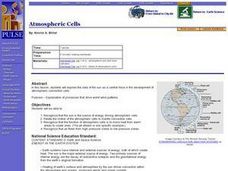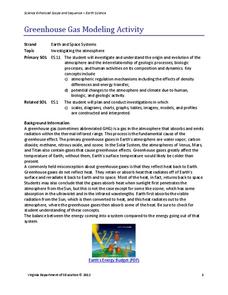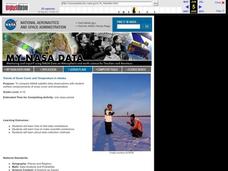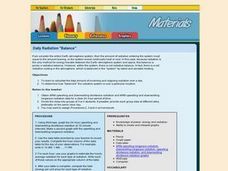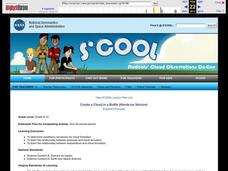Curated OER
Energy from the Sun
For this energy worksheet, students complete a chart on the three types of heat transfer and their causes. Then they explain why all of the radiation directed at Earth does not reach the surface. Students also explain the factors in the...
Curated OER
Plugged in to CO2
Students use a meter to measure the energy used and carbon produced by electronics and appliances. In this environmental science and technology lesson plan, students use a Kill-A-Watt meter to determine the electricity used by everyday...
Curated OER
Gallery Walk Questions on Earth's Radiation Balance
Questions that can be used in a lesson on Earth's radiation balance are suggested in this resource. It is not a lesson plan, per se, but it is a list of questions for stations within a "Gallery Walk" lesson. The link to how Gallery Walks...
Teach Engineering
Six Minutes of Terror
Help your class understand the design challenges when trying to land a remote spacecraft on a planet. Class members examine the provided information to understand how each component of a spacecraft is designed in order to safely land a...
It's About Time
Photosynthesis, Respiration, and the Carbon Cycle
Provide your class with the opportunity to view our carbon cycle close up. Young scientists research the cycle of oxygen as it completes the tasks of photosynthesis and respiration. They explore the importance of carbon in an ecosystem...
Curated OER
Atmospheric Processes - Radiation
Students investigate how different surfaces absorb heat, and how the physical characteristics of a surface have a powerful effect on the way a surface absorbs and releases heat from the sun.
Curated OER
Atmospheric Processes - Conduction
Students explain the process of conduction using a molecular explanation, and explain how different materials conduct at different rates.
Curated OER
Ecology 5 - Carbon and Oxygen Cycles
Students construct their own diagrams outlining the pathway of carbon and oxygen in our atmosphere. They listen to a lecture on the carbon cycle while drawing an example of the carbon cycle on the board. Students comprehend that CO2 is...
Curated OER
Atmospheric Cells
Students recognize that the sun is the source of energy driving atmosphere cells. They relate the motion of the atmospheric cells to mantle convection cells. Students recognize that the function of atmospheric cells is to move heat from...
Curated OER
Thermochemistry
In this thermochemistry worksheet, students calculate the enthalpy of vaporization as well as the write the thermochemical expression for the production of the chemical reaction.
Curated OER
Create a Cloud in a Jar (Hands-on Version)
Students examine the conditions necessary for cloud formation. In this clouds lesson students complete an activity that shows them atmospheric pressure.
Virginia Department of Education
Greenhouse Gas Modeling Activity
Why are greenhouse gases called greenhouse gases? Young Earth scientists learn about greenhouse gases though experimentation in the second installment of a 3-part series. They use lamps to model radiant energy as well...
Curated OER
The Tropopause
For this tropopause worksheet, students read about the temperature of the air in the tropopause or the layer of the atmosphere closest to the Earth. They answer four critical thinking questions about this layer and the energy changes...
Curated OER
Chemistry in Action
In this chemistry in action worksheet, learners read about sulphuric acid, the use of metals, the production of titanium and the detection of chemical elements and compounds. Students are given 8 statements about what they should...
Space Awareness
Water is a Heat Sink
One of the key objectives of Europe's Copernicus Earth program is to monitor the temperatures of the oceans and seas on Earth. Young scholars learn the effects of different heat capacities through two experiments. These experiments...
Curated OER
Energy from the Sun
In this energy from the sun worksheet, learners are given 20 terms to complete sentences about the sun, the energy of the sun, the radiation of the sun, the transfer of energy from the sun and the currents created by the energy of the sun.
Curated OER
Trends of Snow Cover and Temperature in Alaska
Students gather historical snow cover and temperature data from the MY NASA DATA Web site. They compare this data to data gathered using ground measurements from the ALISON Web site for Shageluk Lake. They graph both sets of data and...
Curated OER
Seasons and Cloud Cover, Are They Related?
Students use NASA satellite data to see cloud cover over Africa. In this seasons lesson students access data and import it into Excel.
Curated OER
Using Radiosonde Data From a Weather Balloon Launch
Student use radiosonde data from a weather balloon launch to distinguish the characteristics of the lower atmosphere. They learn the layers of the atmosphere. They graph real atmospheric data.
Curated OER
Daily Radiation "Balance"
Students explore the amount of radiation in the Earth's atmosphere. They calculate the total amount of incoming and outgoing radiation over a day and determine how "balanced" the radiative system is over a particular location.
Curated OER
It's Gettin' Hot In Here, So Transfer Energy
Pupils study the means by which energy is transferred from the sun through the Earth's atmosphere. They examine radiation, conduction, and convection. They complete a lab to determine how the different transfers affect the atmosphere and...
Curated OER
IPC Textbook Guided Reading-Chapter 27-Heat
In this heat worksheet, students answer 21 short answer questions about heat transfer through conduction and convection, thermal conduction and conductors.
Curated OER
Trouble in the Troposphere
Students Use data sets from MY NASA DATA to produce graphs comparing monthly and yearly ozone averages of several U.S. cities. They analyze and evaluate the data and predict trends based on the data. In addition, they discuss and...
Curated OER
Create a Cloud in a Bottle
Students investigate the conditions needed for cloud formation and explore how pressure and temperature effect cloud formation. In this atmospheric pressure lesson students complete a lab on cloud formation.








